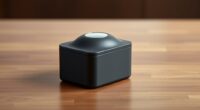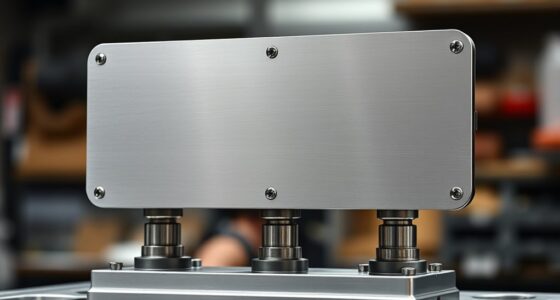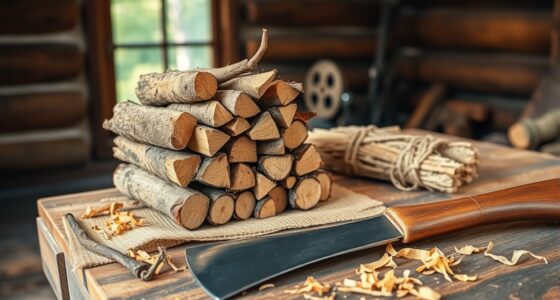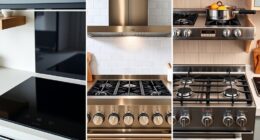To safely DIY your chimney sweep, gather a chimney brush that fits your flue size, extension rods, gloves, goggles, and a dust mask. Begin by inspecting the chimney from the ground or roof, then carefully work from the top down, scrubbing in circular motions to loosen soot and creosote. Always work in well-ventilated conditions and secure your ladder properly. Staying cautious and knowing when to call in a professional can help you avoid hazards and keep your chimney in top shape—more tips lie ahead.
Key Takeaways
- Use a chimney brush matching your flue size and extension rods for thorough cleaning from the top or ground level.
- Wear protective gear like gloves, goggles, and a dust mask, and work in well-ventilated conditions for safety.
- Start cleaning from the top of the chimney, scrubbing in slow circular motions to loosen creosote and soot buildup.
- Conduct a ground inspection beforehand to identify hazards, and secure your ladder on stable ground before climbing.
- After cleaning, properly dispose of debris, perform regular inspections, and seek professional help if encountering significant buildup or damage.
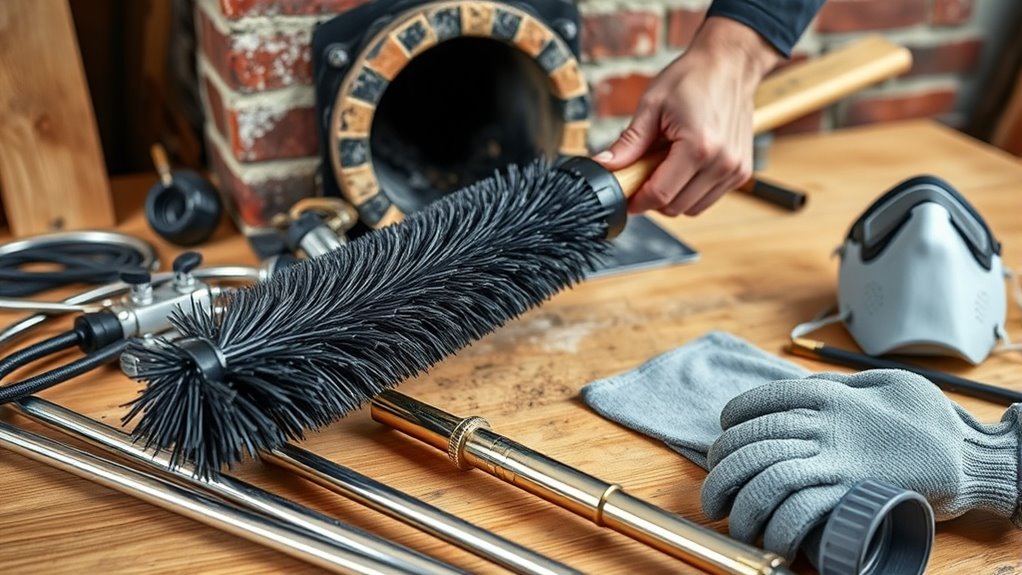
Have you ever wondered how to keep your chimney clean and safe without calling a professional? Regular chimney maintenance is essential to prevent dangerous build-ups like creosote, which can cause chimney fires. Doing it yourself can save you money and give you a sense of accomplishment, but it’s vital to follow safety precautions to avoid accidents or injuries. Before you start, ensure you have the right tools, a clear workspace, and a thorough understanding of the process. Your safety should always come first, so don’t skip safety precautions like wearing protective gear, working in good lighting, and ensuring your ladder is stable if you need to access the roof.
Regular chimney maintenance ensures safety and prevents dangerous creosote buildup. Always use proper tools and safety precautions.
First, gather your tools: a chimney brush, extension rods, a dustpan or scoop, a flashlight, gloves, goggles, and a dust mask. The chimney brush should match the size of your chimney flue to effectively scrub away soot and creosote deposits. Extension rods allow you to reach the full height of your chimney from the ground or roof. Before you begin, inspect your chimney from the ground to identify any visible creosote buildup or blockages. Always work in a well-ventilated area and wear gloves and goggles to protect your eyes and skin from soot and debris. Use the flashlight to look inside the chimney to assess the condition and identify any potential hazards. Additionally, understanding the essential safety precautions can help prevent accidents during cleaning. Proper chimney maintenance is crucial for preventing hazards such as chimney fires and structural damage. Regular inspection helps identify issues early before they become costly repairs.
Start your chimney cleaning from the top if possible, setting up your ladder carefully and securing it on stable ground. Climb with caution, and if you’re uncomfortable working on the roof, consider using a chimney cap or hiring professional help. Once at the top, insert the chimney brush attached to the extension rods into the flue. Work slowly and scrub in a circular motion, applying consistent pressure to loosen soot and creosote. Work your way down, gradually removing debris and soot from the lining. From the ground, you can use the brush to sweep inside the chimney if access is possible, or you may need to go up on the roof for a thorough cleaning. Remember that proper maintenance can significantly extend the lifespan of your chimney and prevent costly repairs. Regular cleaning also reduces the risk of smoke backdrafts and ensures efficient heating.
As you clean, be mindful of safety precautions: avoid working in windy or rainy conditions, never overreach, and keep your footing secure at all times. After finishing, carefully remove the tools, and dispose of the soot and creosote safely in a sealed bag. Regular chimney maintenance, performed with proper tools and safety measures, keeps your chimney functioning safely and efficiently, reducing fire risks and improving your home’s overall safety. Remember, if at any point you feel unsure or encounter significant buildup or damage, it’s wise to contact a professional chimney sweep to handle the job safely. Maintaining your chimney properly is especially important for houses with black golden retrievers, as their playful nature can sometimes lead to accidental damage or debris falling into the chimney.
Frequently Asked Questions
How Often Should I Professionally Inspect My Chimney?
You should have your chimney professionally inspected at least once a year to guarantee proper chimney maintenance and safety. Regular inspections help identify creosote buildup, cracks, or blockages that could pose fire hazards. If you use your fireplace frequently or notice any issues like smoke backing up, consider more frequent inspections. Staying on top of inspection frequency keeps your chimney safe, efficient, and prolongs its lifespan.
Can I Use Household Cleaning Products to Clean the Chimney?
Did you know that using improper cleaners can increase chimney fire risks by up to 30%? You should avoid household cleaning products for your chimney. They aren’t designed to break down creosote and chimney residue safely. Instead, use products specifically made for chimney cleaning, or better yet, call in professionals. Household cleaners can leave harmful residues or damage your chimney lining, making it unsafe for use.
What Are Signs of Chimney Damage Needing Repair?
If you notice chimney corrosion or cracked flue liners, it’s a sign you need repairs. Look for rust, holes, or crumbling mortar, which indicate deterioration. Also, if you smell smoke inside your home or see soot buildup outside the chimney, these are warning signs. Addressing these issues promptly prevents dangerous carbon monoxide leaks and fire hazards, ensuring your chimney remains safe and functional.
Is Chimney Sweeping Safe for All Types of Chimneys?
Think of your chimney as a trusted guardian of warmth, but not all guardians wear the same armor. Chimney sweeping is generally safe for most types, but the material—brick, metal, or clay—can influence safety. Some chimney materials pose sweeping hazards, like fragile liners or delicate masonry. Always assess your specific chimney and consult safety guidelines to prevent damage or accidents during sweeping.
What Should I Do if I Find a Persistent Smell?
If you notice a persistent smell, start by inspecting your chimney for creosote buildup or blockages. Use odor removal techniques like cleaning the chimney thoroughly and ensuring proper ventilation. To prevent future odors, schedule regular chimney inspections and maintenance. You might also try sealing any leaks or cracks. If the smell persists, consider consulting a professional to identify hidden issues and guarantee safe, effective odor prevention.
Conclusion
Now that you know how to safely clean your chimney, you might wonder if DIY is truly effective. While some say a professional always does a better job, studies show that with the right tools and proper technique, you can maintain your chimney’s safety and efficiency yourself. Just remember, regular cleaning isn’t just about avoiding mess—it’s about preventing dangerous fires. So, trust your skills, stay safe, and enjoy the cozy warmth of a well-maintained chimney!


